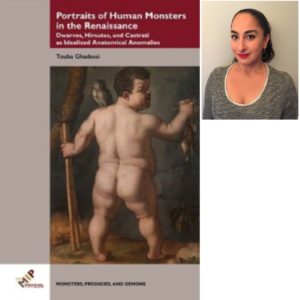Podcast: Play in new window | Download
Subscribe: Apple Podcasts | RSS

Touba Ghadessi is an Associate Professor of Art History at the Wheaton College Massachusetts. We spoke about her book on how the “monstrous” form was portrayed in 16th and 17th century art found among noble courts.
3:45 – Touba talks about the book and what it means to be a monster in the 16th century.
8:00 – Touba thought she might find definite categories of “monsters” but the meaning was more porous. Courts loved having dwarves at court.
12:00 – Touba talks about a dwarf that was taught to fight, to speak other languages and taught many different skills by his court patrons. Some dwarves were mentally incapacitated and used as jesters sometimes.
21:24 – There’s a long history of dwarfism in other cultures being a perfect miniature representation of a human being.
25:45 – In the 16th century, anatomists started looking at dwarves as biological entities rather than omens of something.
27:30 – Touba could look at purchase inventories for courts to see what was being bought for dwarves by their patrons.
29:30 – She mostly got records from Northern Italian courts and some French courts.
38:00 – It was difficult for Touba to read about the vivisection work that some 16th century scientists did.
For more of “The Art and Design of Sci-Fi and Fantasy, Mystery and Horror” please follow me on Facebook at crisalvarezwlc, on youtube at Cris Alvarez and on Instagram @crisalvarezscifi
Guests: Touba Ghadessi
Host: Cris Alvarez
Tags: art, dwarf, hirsute, paintings, 16th century, 17th century, italy, france, nobility, castrati, royal courts
